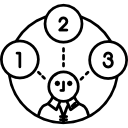CLI

A command-line interface or command language interpreter (CLI), also known as command-line user interface, console user interface, and character user interface (CUI), is a means of interacting with a computer program where the user (or client) issues commands to the program in the form of successive lines of text (command lines).[2]
We interact with a command line interpreter via a terminal. A terminal window allows the user access to a text terminal and all its applications such as command-line interfaces (CLI) and text user interface (TUI) applications. These may be running either on the same machine or on a different one via telnet, ssh, or dial-up. On Unix-like operating systems, it is common to have one or more terminal windows connected to the local machine.[3]
Command line
The command line interface is an interface to your operating system. Using a command line interface, you can look create, read, update and delete files. You can run programs, and you can manage and view important parts of your operating system.
As opposed to a graphical user interface (GUI) a command line is less abstract. The command line abstracts file system, but less so than a GUI. The command line interface is sparse, not very visual, but "more true" in my opinion. I prefer the command line because it removes one layer of abstraction from my work.
Every programmer or computer scientist should have skill and knowledge related to using the command line in order to get stuff done.
An advantage to using the command line[4]:
- a faster way to get tasks done
- it is more flexible than a GUI
- it uses less memory
Please click here for an excellent "cheat sheet" for command line [5]. For an interactive version of the same document please click here